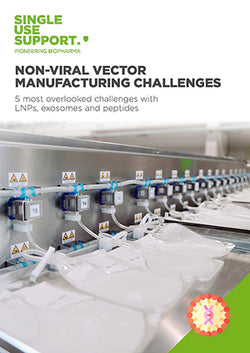Where are lipid nanoparticles (LNPs) used?
In the realm of nanomedicine, lipid nanoparticles (LNP) have emerged as versatile delivery vehicles, revolutionizing drug delivery and biomedical research. LNPs (liposomes and nanostructured lipid carriers) are at the forefront of nanotechnology advancements, offering unique advantages for targeted therapies and efficient transport of small molecules.
Their nanostructured composition enables precise control over drug release, enhancing therapeutic efficacy while minimizing side effects. LNPs have garnered significant attention in various fields, owing to their potential in improving bioavailability and overcoming delivery challenges.
LNPs and their role in medicine and bioresearch
Lipid nanoparticles (LNPs) have emerged as promising drug delivery systems in the field of therapeutics, revolutionizing the treatment landscape. As alternatives to polymers and other carrier systems, different formulations of liposomes and solid lipid nanoparticles open new chances for targeted drug delivery.
LNPs play a crucial role as non-viral vectors for various therapeutics, including nucleic acids, peptides, antibodies, RNA and other small molecules, to their intended targets. These nanoparticles are vesicles that employ a combination of lipid components, such as phospholipids, cationic or anionic lipids, and ionizable lipids, to optimize their formulation and payload encapsulation.
Lipid nanoparticles (LNPs) have also gained significant attention in biomedical research, playing a crucial role in various areas, including vaccine development and various therapeutic interventions. LNPs, formulated with components such as cationic lipids, cholesterol, and polyethylene glycol (PEG), offer unique advantages for targeted delivery and immune response modulation that are far from being entirely discovered.
LNPs for mRNA delivery and gene therapy
LNPs for mRNA delivery and gene therapy are able to transport nucleic acids, such as plasmid DNA or mRNA, to target cells. The incorporation of ionizable lipids facilitates endosomal escape and promotes intracellular delivery of the genetic payload.
LNPs have demonstrated high transfection efficiency in vitro. And with Onpattro as a siRNA-LNP gene therapy product, the first LNP therapeutic has been approved by the FDA in 2018. Since then, LNPs have demonstrated success in various therapeutic interventions based on gene delivery, further exemplified by Patisiran, an LNP-based therapy for hereditary transthyretin amyloidosis. [[1]]
LNPs utilize self-assembly processes to form lipid bilayers, enabling efficient encapsulation and delivery of therapeutic cargo for its cellular uptake. Homogenization and solvent evaporation techniques are employed during LNP synthesis to achieve controlled particle size and stability. Conjugation of ligands to the LNP surface enhances targeting specificity, directing the particles to specific receptors on the cell membranes. [[1]]
LNPs in cancer therapy
LNPs, or lipid nanoparticles, have been heavily investigated as promising tools to produce effective cancer therapy due to their ability to encapsulate and deliver anticancer agents with improved efficiency and specificity. One of the key advantages of LNPs is their capacity to solubilize hydrophobic drugs within their aqueous lipid core.
This solubilization enhances the stability and bioavailability of the drugs, allowing for effective systemic administration. LNPs can protect the encapsulated drugs from degradation and clearance in the bloodstream, thereby increasing their circulation time and improving their biodistribution to the tumor site.
Moreover, LNPs can be engineered to actively target cancer cells, enhancing their specificity and reducing off-target effects. This can be achieved by modifying the surface of the LNPs with targeting ligands such as antibodies or peptides that recognize specific receptors overexpressed on cancer cells. The targeted LNPs can bind to these receptors, promoting their selective internalization by cancer cells through receptor-mediated endocytosis.
This active targeting strategy enhances the accumulation of anticancer agents within cancer cells, maximizing their therapeutic efficacy while minimizing damage to healthy tissues.
LNPs in mRNA-based vaccine development
LNPs have revolutionized vaccine development, particularly in the context of mRNA vaccines developed as a reaction to the SARS-CoV-2 pandemic. Prominent examples include the Pfizer-BioNTech and Moderna COVID-19 vaccines.

LNPs encapsulate and protect mRNA encoding viral antigens, facilitating their delivery to target cells. Following endocytosis and intracellular processing, the mRNA is translated in the cytoplasm, leading to antigen presentation and the induction of an immune response.
Other fields of LNPs applications
Apart from medical and biomedical research, lipid nanoparticles (LNPs) have found applications in various other fields. LNPs are utilized in industries such as cosmetics, agriculture, and food and beverage, as well as in environmental remediation.
These versatile particles offer unique properties for encapsulating and delivering active ingredients, enhancing product efficacy, stability, and targeted delivery.
Furthermore, LNPs have shown potential in environmental applications, including the remediation of pollutants and the delivery of agricultural agents for crop protection.
Status Quo: Fields of application, optimization and challenges
To sum up, LNPs are used or being investigated for usage in:
- gene therapy
- vaccines
- cancer therapy
- regenerative medicine
- non-medical applications (e.g. agriculture or cosmetics)
The optimization of LNPs involves careful consideration of various parameters, including particle size, surface charge, lipid composition, and encapsulation efficiency. Strategies such as PEGylation with pegylated lipids or incorporation of surfactants help improve stability, circulation time, and immune system evasion. [[2]]
However, challenges remain, including the potential for cytotoxicity and aggregation. Researchers are actively developing innovative approaches, such as microfluidic techniques and formulation modifications, to enhance LNPs' delivery efficiency and therapeutic efficacy, also aiming for a decrease in toxicity and potential side effects at in vivo application. [[2]]
LNPs have shown great promise in preclinical studies and are currently being evaluated in clinical trials for various indications. These lipid nanoparticle formulations hold immense potential in revolutionizing drug delivery systems and improving the outcomes of therapeutic interventions, with the aim of providing more effective treatments while minimizing side effects. [[2]]
Single-use technologies to facilitate LNP manufacturing
The widespread adoption of lipid nanoparticles (LNPs) in various applications faces challenges, particularly in LNP manufacturing. The production of LNPs requires specialized equipment and processes to ensure consistent quality and scalability. Traditional manufacturing methods often involve complex cleaning and validation procedures, hindering efficiency and increasing costs.
Furthermore, LNPs require dedicated freezing processes, preventing them from deterioration due to temperature inconsistency or unsuitable freezing rates. However, LNPs are an indispensable tool to protect mRNA stability during controlled and fast freezing and thawing processes, ensuring viability of the mRNA for its subsequent application.

To address these challenges, the use of single-use technology (SUT) has gained prominence. Single-use bioprocessing offers a practical solution by eliminating the need for cleaning and reducing the risk of cross-contamination. It enables flexible and efficient manufacturing, allowing for faster scale-up and process optimization. Additionally, closed systems based on single-use systems allow for more streamlined processes and are therefore able to minimize the risk of protocol deviations or cross-contamination.
Single Use Support has set up an entire product line-up that accompanies the critical steps in LNP manufacturing, such as filling and aliquoting lipid nanoparticles, but also freezing LNPs and associated mRNA-based therapies for long-term stability. These systems pay tribute to the unique character and requirements of LNPs and LNP-based products in terms of thermal and physical stress, but also help to prevent loss of product and quality inconsistencies with the means of automated processes, both for lab and large-scale.
References
- Lipid nanoparticles for mRNA delivery, http://dx.doi.org/10.1038/s41578-021-00358-0, Published 2021-08-10
- Lipid nanoparticles for delivery of RNA therapeutics: Current status and the role of in vivo imaging, http://dx.doi.org/10.7150/thno.77259, Published 2022-10-27

Download guide
Guide: Challenges in Non Viral Vector Manufacturing
Guide about navigating 5 of the most overlooked challenges in non-viral vector manufacturing with regards to fluid management challenges, such as degradation and instability of LNP during freezing, scalability concerns in exosome manufacturing or protection against toxic solvents in peptide manufacturing.
